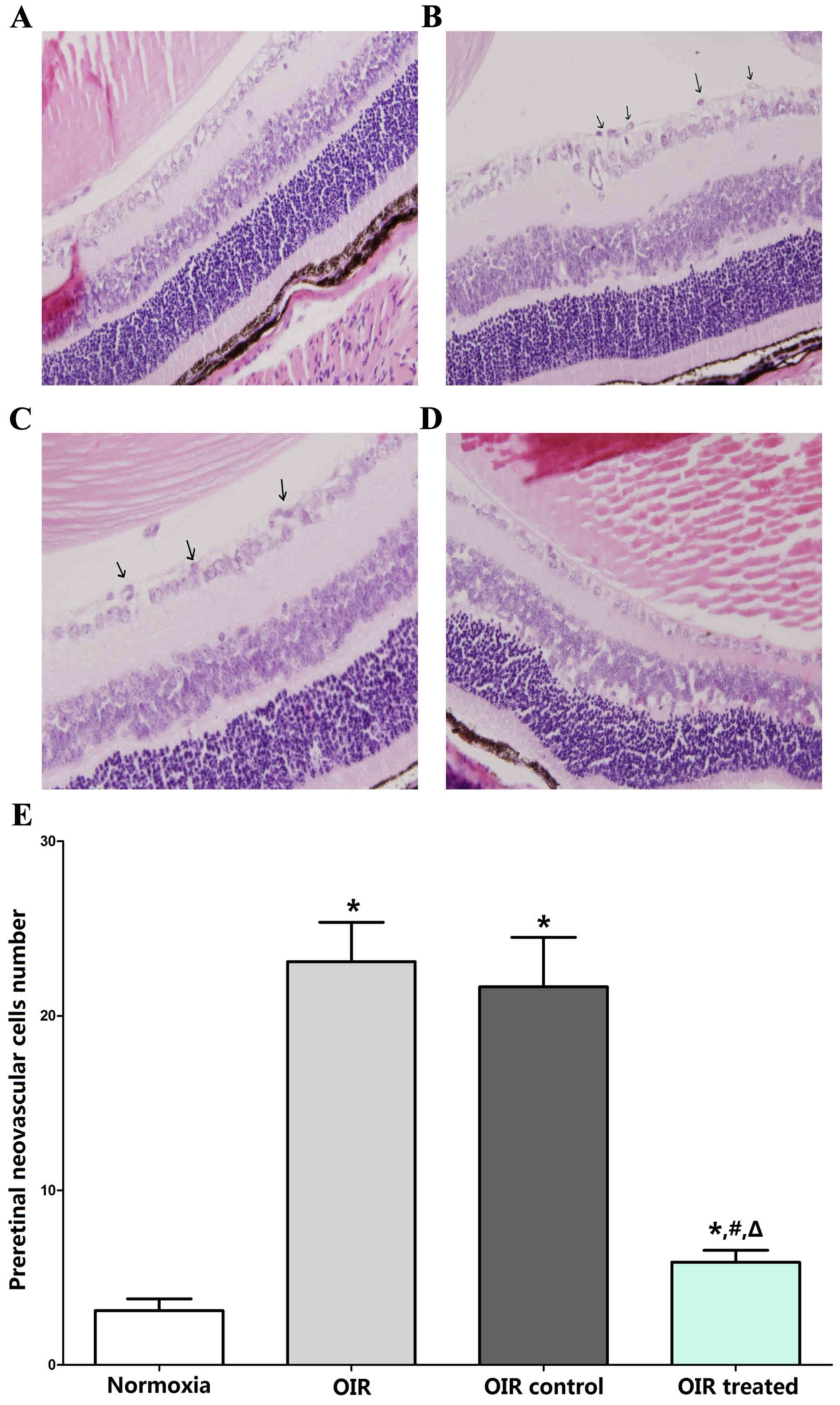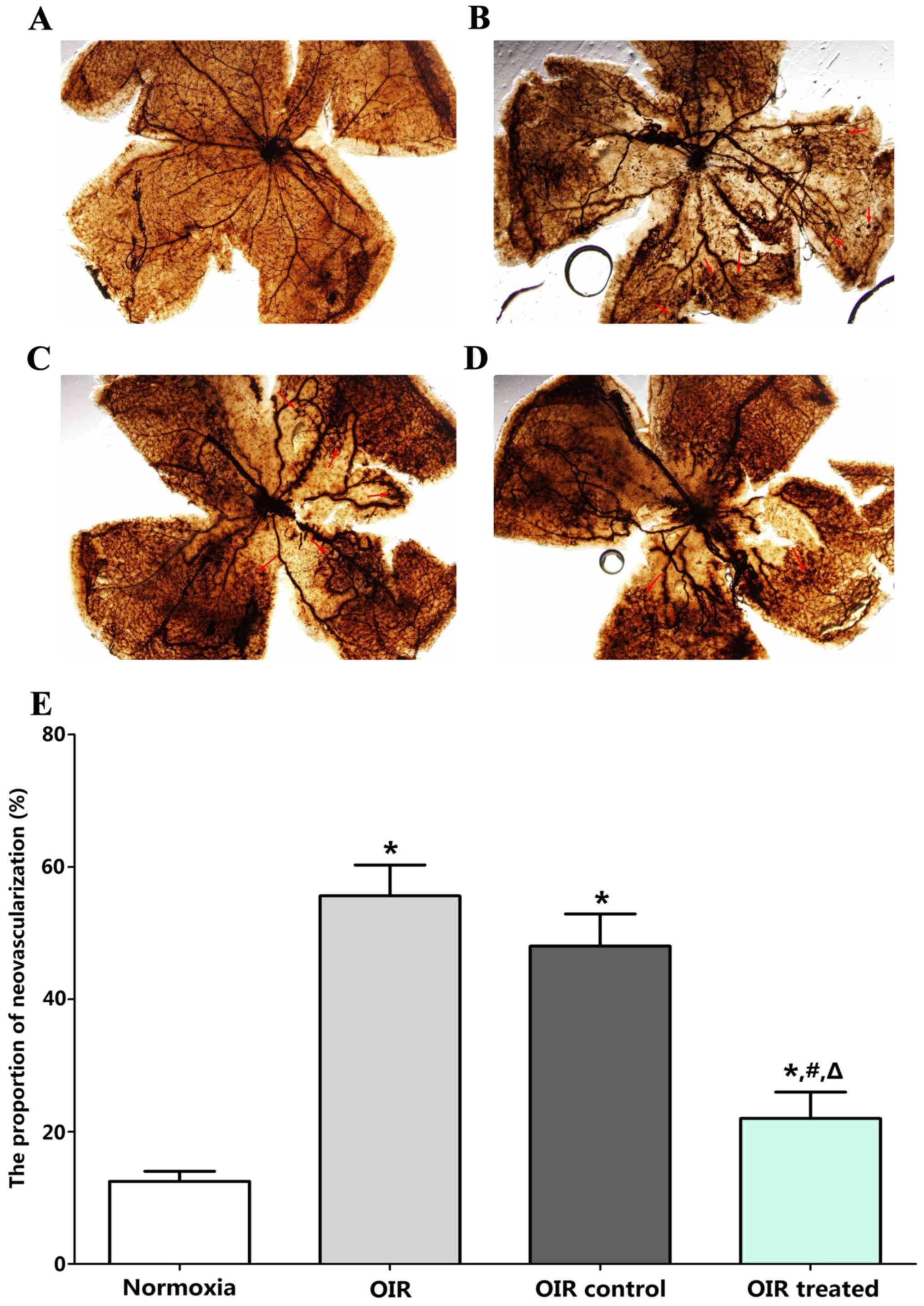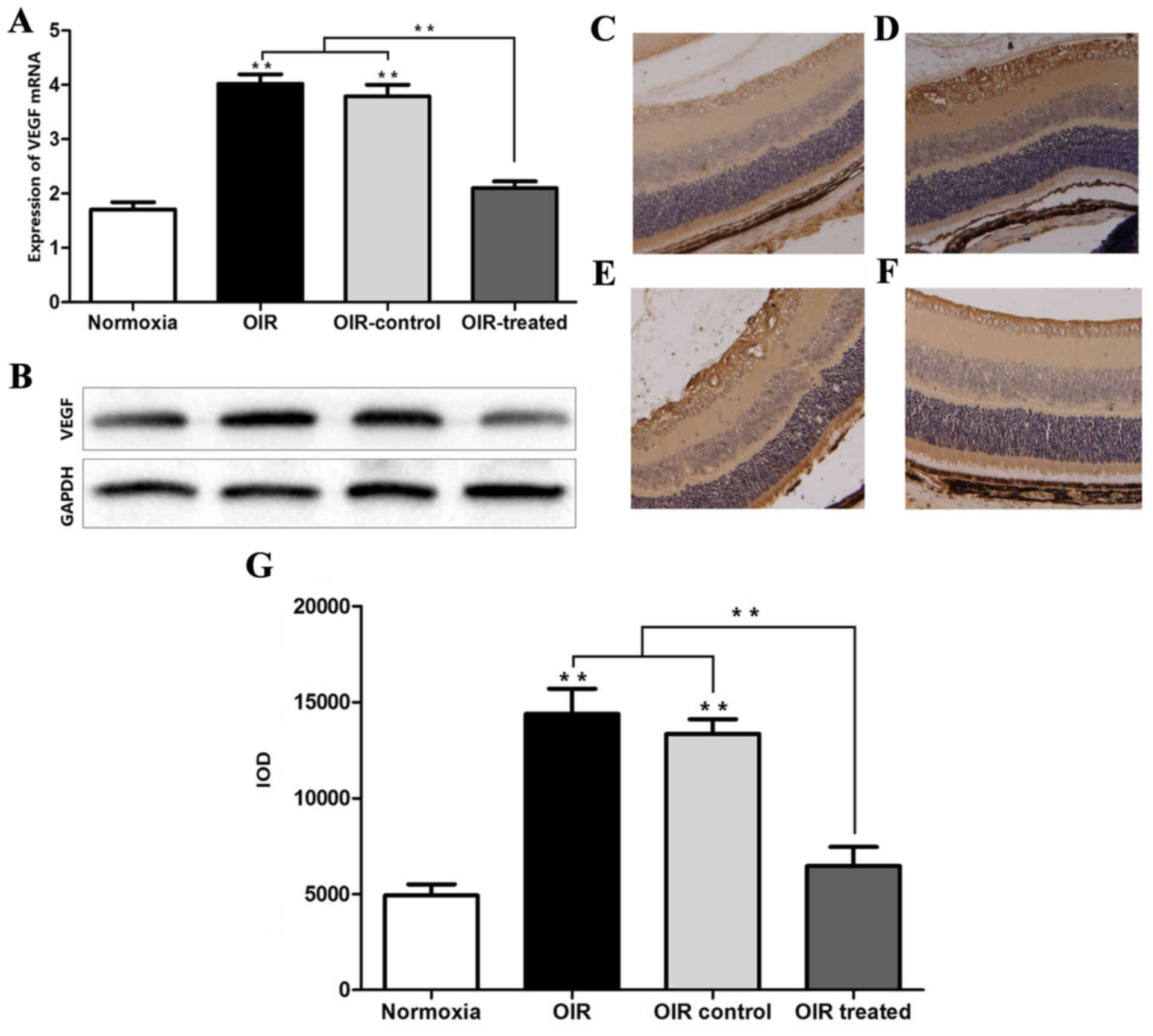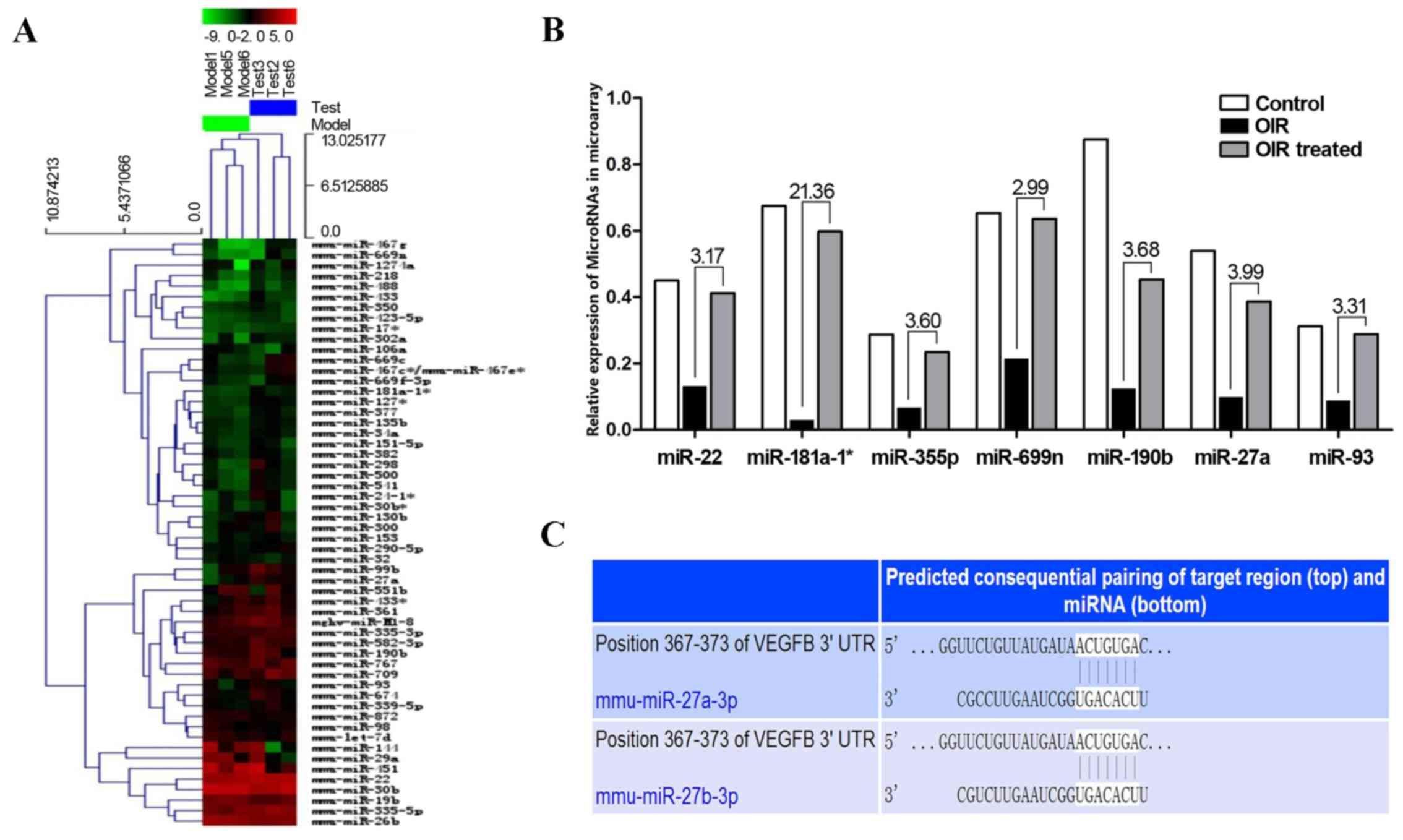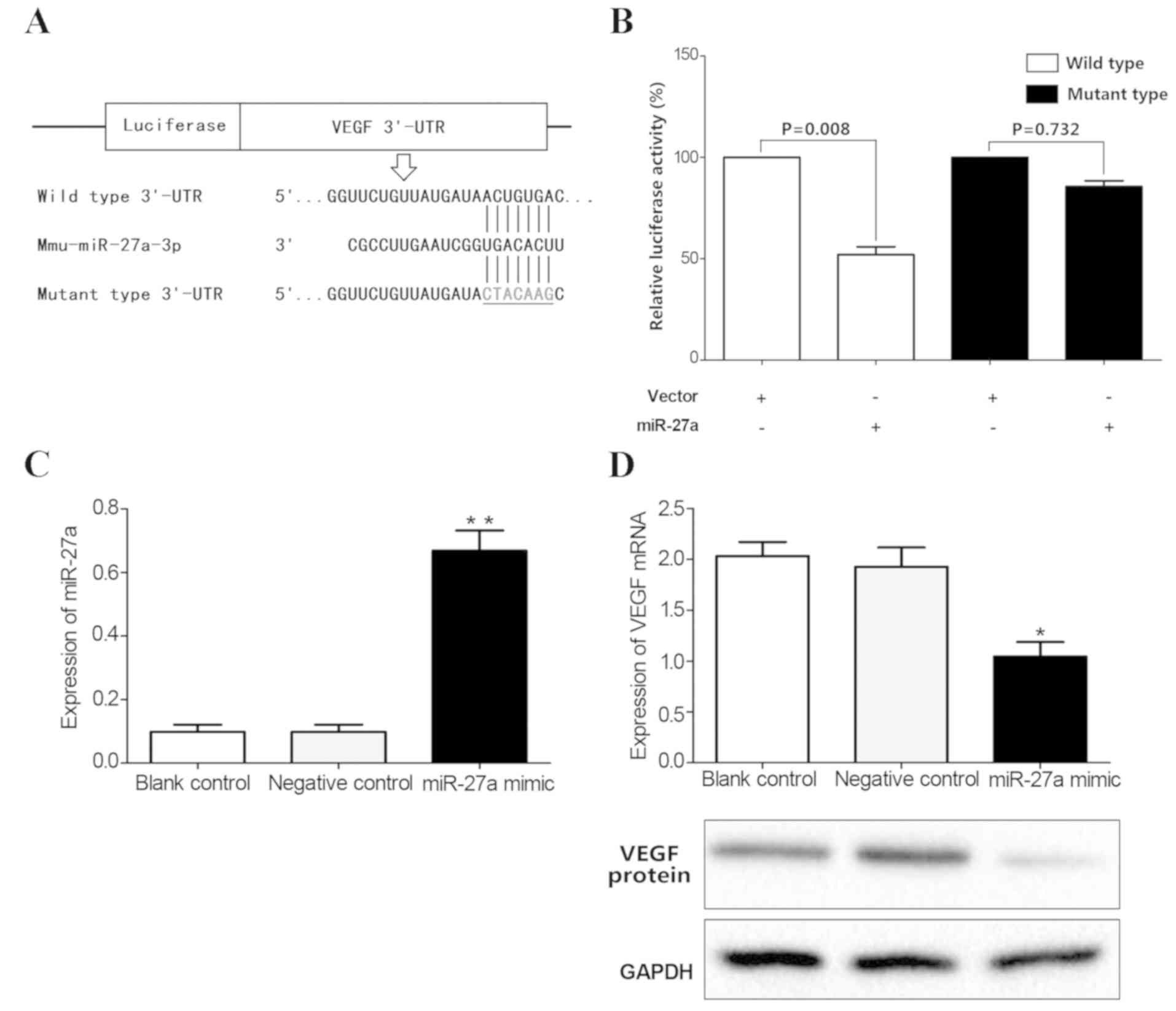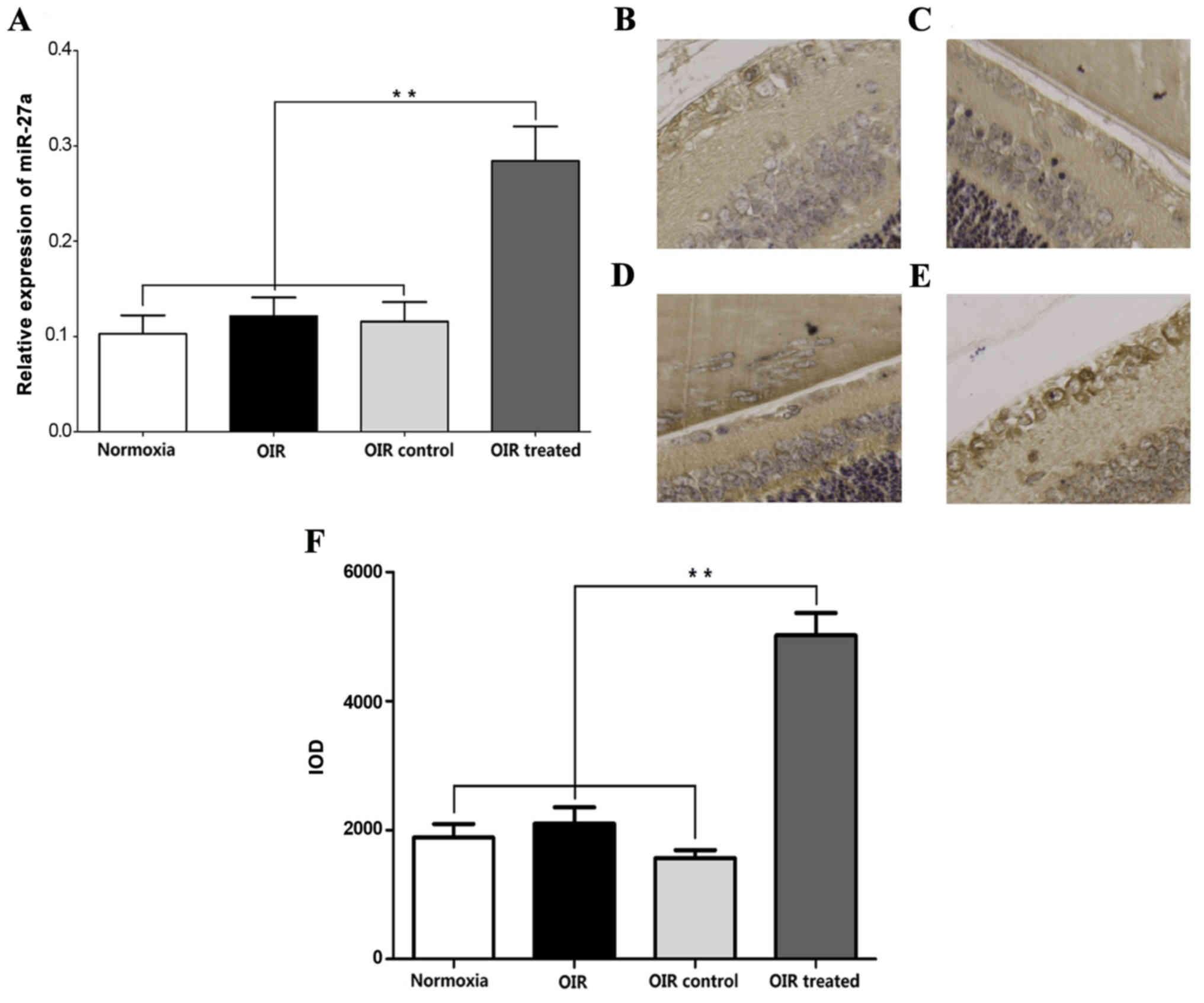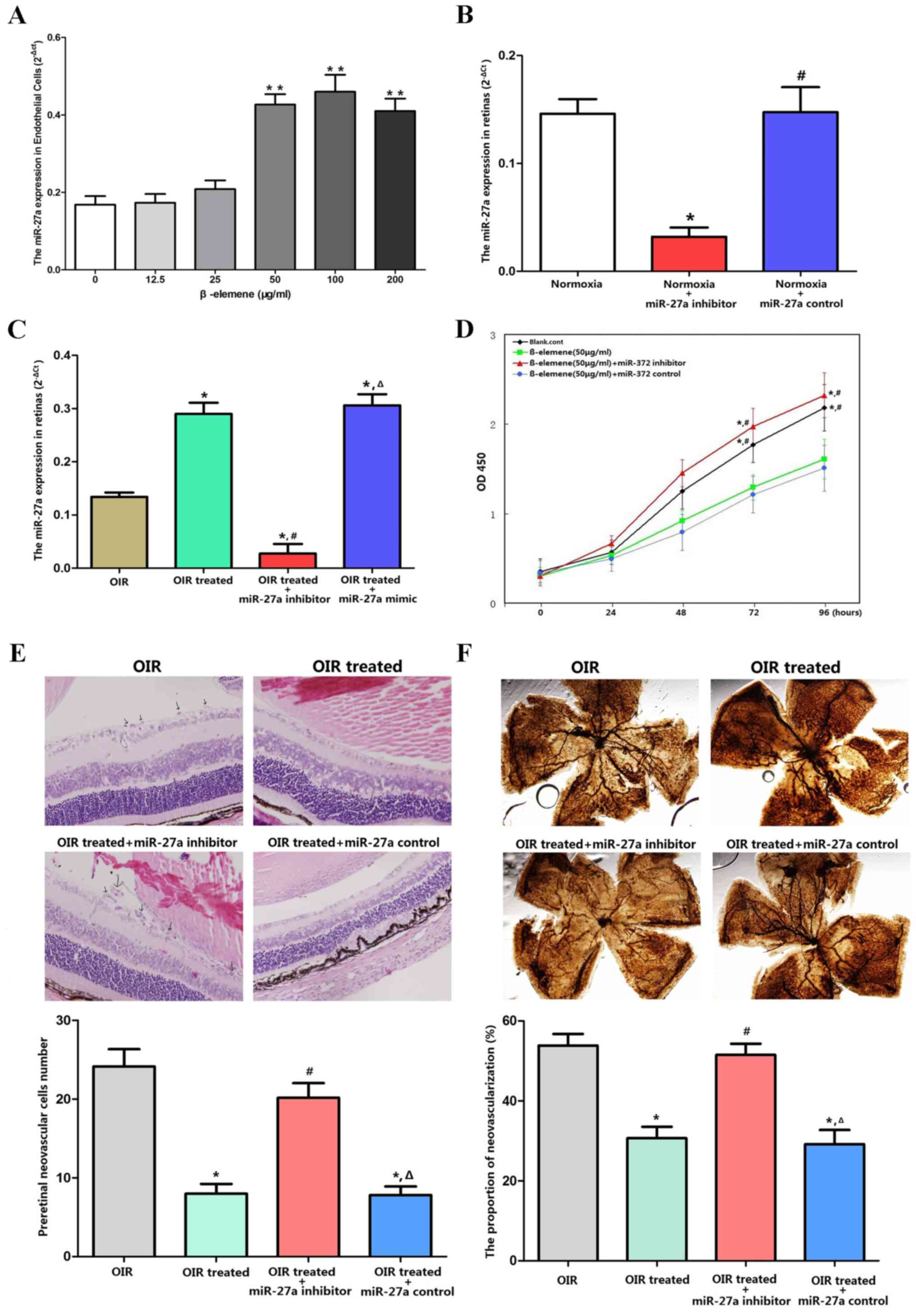β‑elemene inhibits oxygen‑induced retinal neovascularization via promoting miR‑27a and reducing VEGF expression
- Authors:
- Published online on: January 15, 2019 https://doi.org/10.3892/mmr.2019.9863
- Pages: 2307-2316
Abstract
Introduction
Intraocular neovascularization is an important clinical manifestation which is the pathological basis for numerous ocular disorders, such as proliferative diabetic retinopathy, ischemic central retinal vein occlusion and retinopathy of prematurity (1–3). No effective treatment for retinal neovascularization (RNV) is available to date. Recent studies have shown that retinal angiogenesis may due to complex interactions among multiple angiogenic stimulators (4,5).
β-elemene, isolated from the Chinese medicinal herb Zedoary (Curcuma zedoaria) exhibits substantial clinical activity against various cancers in vitro and in vivo (6–8). β-elemene reduces the proliferation of blood vessel endothelial cells during tumor progression by inhibiting the expression of angiogenic factors, such as vascular endothelial growth factor (VEGF) and Notch-1 (9,10). The previously reported effects of β-elemene in vascularization prompted us to examine the therapeutic effects of β-elemene on RNV. The present study investigated the suppressive effects of β-elemene on RNV in a mouse model of oxygen-induced retinopathy (OIR). The results showed that β-elemene inhibited RNV in OIR mice and downregulated the expression of VEGF in the retina.
It is well known that VEGF is an important factor that stimulates endothelial cell proliferation and tube formation, and also mediates oxygen-induced RNV (11,12). Therefore, understanding the abnormal regulation of VEGF may contribute to the identification of effective RNV therapies. In order to elucidate the underlying mechanisms of β-elemene-mediated inhibition of VEGF expression, the present research focused on microRNAs (miRNAs/miRs). Previous studies have shown a series of miRNAs, including miR-9, miR-410 and miR-146a, inhibit retinal neovascularization by targeting VEGF (13–15).
In the present study, miRNA microarrays were used to screen the miRNAs with different expression levels between the OIR and β-elemene-treated groups. Prediction websites TargetScan and miRanda, as well as luciferase assays, were used to demonstrate that miR-27a directly bound to the 3′-untranslated region (UTR) of VEGF and inhibited its expression, suggesting that VEGF was a direct target of miR-27a. In addition, it was demonstrated that β-elemene upregulated miR-27a expression in vivo and in vitro. Furthermore, miR-27a inhibitor transfection eliminated the effects of β-elemene on RNV, suggesting that β-elemene reduced RNV via miR-27a.
Taken together, it was concluded that β-elemene inhibited RNV in OIR mouse models, by reducing VEGF expression via miR-27a upregulation. This novel finding may encourage further exploration of the role of β-elemene in the pathogenesis of these diseases.
Materials and methods
Animals
Animal experiments were conducted following the guidelines of the Animal Experiment Committee of The First Affiliated Hospital of China Medical University, and the study was approved by the ethics committee of The First Affiliated Hospital of China Medical University (Shenyang, China). Mice were maintained in a 12 h light/dark cycle at 23–25°C with 50–60% humidity. C57BL/6J neonatal mice (23–28 g; routinely fed water and food) were used to establish OIR models on postnatal day 7 (P7), according to the Smith's method (16). A total of 80 mice (37 male and 43 female) were randomly divided into 4 groups: i) Normoxia; ii) OIR; iii) OIR control; and iv) OIR treated. Mice in the normoxia group were maintained under normoxic conditions (oxygen concentration, 15±2%) for 17 days. The mice in the OIR group were exposed to 75±5% oxygen for 5 days and returned to a normal oxygen environment on P12. The OIR control and OIR treated groups were intravitreally injected with 1 µl lipid emulsion (0.25 mg/ml; Dalian Yuanda Pharmaceutical Co., Ltd., Dalian, China) and β-elemene (0.25 mg/ml, Dalian Yuanda Pharmaceutical Co., Ltd.), respectively, on P12 and subsequently returned to a normal oxygen environment for 5 days (P12-P17). Rats were anesthetized with chloral hydrate (430 mg/kg; 4.3%) prior to intravitreal injection.
Observation of RNV
On P17, all mice were sacrificed and the eyes were harvested. The cornea, lens and vitreous humor were removed, and the retinas were surgically dissected. The retinas were fixed with 4% paraformaldehyde for 8 h at 37°C, and retinal sections (1 mm) were prepared for adenosine diphosphatase (ADPase) staining (10% ammonium sulfide) and flat-mounted on microscope slides with a gelatin-coated coverslip. Each retina was divided into 12 equal segments and observed under an optical microscope (×200; Olympus Corporation, Tokyo, Japan) and the proportion of neovascularization areas were counted, as described previously (17). Three independent reviewers were blinded to grouping to assess the severity of RNV.
Quantification of RNV
The mice were sacrificed, and the eyes were enucleated, immersed in 40 g/l paraformaldehyde in PBS for at least 24 h at 37°C and embedded in paraffin. Serial 6-µm sections from all eyes were cut sagittally, parallel to the optic nerve and stained with hematoxylin and eosin (H&E) for 3 min at 37°C. The preretinal neovascular cell nuclei, identified under a light microscope (×200), were considered to be associated with new vessels if they were found on the vitreal side of the internal limiting membrane (ILM) (18). The preretinal neovascular cells were counted to quantitatively assess RNV (11,19). All retinas were examined in five serial sections. Three independent reviewers were blinded to grouping when counting the cells.
RNA preparation and reverse transcription-quantitative polymerase chain reaction (RT-qPCR)
Total RNA was extracted from retinal tissues by TRIzol reagent (Invitrogen; Thermo Fisher Scientific, Inc., Waltham, MA, USA) following the manufacturer's protocol. RT-qPCR was performed using SYBR Premix Ex Taq (Takara Bio, Inc., Otsu, Japan) on a Thermal Cycler Dice™ Real Time system (Takara Bio, Inc.) using the following thermocycling conditions: 30 sec at 95°C followed by two-step PCR for 40 cycles of 95°C for 5 sec and 64°C for 30 sec. The primer sequences were as follows: VEGF forward, 5′-CAACTTCTGGGCTCTTCTCG-3′; VEGF reverse, 5′-CCTCTCCTCTTCCTTCTCTTCC-3′; miR-27a forward, 5′-CAACTTCTGGGCTCTTCTCG-3′; miR-27a reverse, 5′-GTCAGCGGACTCTGGATTCAG-3′; GAPDH forward, 5′-ATAGCACAGCCTGGATAGCAACGTAC-3′; GAPDH reverse, 5′-CACCTTCTACAATGAGCTGCGTGTG-3′; U6B forward, 5′-CTCGCTTCGGCAGCACATATACT-3′; U6B reverse, 5′-ACGCTTCACGAATTTGCGTGTC-3′. GADPH was used as a reference control of VEGF. U6B was used as a reference control of miR-27a. All primers were purchased from Sangon Biotech Co., Ltd. (Shanghai, China). Relative gene expression data was analyzed using the 2-ΔΔCq method (20).
Immunohistochemistry (IHC)
Retinas were fixed in 4% paraformaldehyde for 48 h at 37°C, embedded in paraffin and cut into 4-µm sections. Following general deparaffinization, antigen retrieval was performed for 1 min with an autoclave using 0.01 mol/l sodium citrate buffer. H2O2 (0.3%) was used to block endogenous peroxidase activity. Goat serum (6%; Maixin-Bio, Fuzhou, China) was used to block the nonspecific immunoglobulin-binding sites for 20 min at 37°C. The slices were incubated overnight with anti-VEGF (1:200; cat. no. 1402390; Sigma-Aldrich, MO, USA) at 4°C, rinsed with PBS and incubated with goat anti-rabbit immunoglobulin G secondary antibody (1:200; Sigma-Aldrich; Merck KGaA, Darmstadt, Germany) for 30 min at 37°C The peroxidase reaction was developed with 3,3′-diaminobenzidine tetrahydrochloride (DAB). The sections were counterstained with Mayer's hematoxylin for 1 min at 37°C, dehydrated, cleared in xylene and mounted in Permount medium (Thermo Fisher Scientific, Inc.).
In situ hybridization (ISH)
The ISH kit was purchased from Wuhan Boster Biological Technology, Ltd. (Wuhan, China) and used according to the manufacturer's protocol. In brief, tissue slides were hybridized with 20 µl 5-digoxigenin LNA-modified-miR-27a-3p (synthesized by Wuhan Boster Biological Technology, Ltd.). The sequence was 5′-TTCAGCCCCATGTTTGCCTC-3′. The peroxidase reaction was developed with DAB.
Quantitative assessment and scoring
The expression of VEGF and miR-27a detected in the immunohistochemical and ISH analysis was quantitatively assessed using Image-Pro Plus Software 6.0 (Media Cybernetics, Inc., Rockville, MD, USA). The integrated optical density of retina sections was calculated by two investigators in a double blinded manner.
Western blot analysis
A total protein extraction kit (Beijing Solarbio Science & Technology, Co., Ltd., Beijing, China) was used to extract protein according to the instructions. Ultraviolet absorption was the protein determination method. Proteins (40 µg/lane) were separated by 10% SDS-PAGE and transferred onto polyvinylidene difluoride membranes. Next, 5% skimmed milk solution in Tris-buffered saline with Tween 20 (0.05%) buffer was used to block the membranes, which were then incubated with VEGF (1:2,000; cat. no. 1402390; Sigma-Aldrich; Merck KGaA), platelet-derived endothelial cell growth factor (PD-ECGF; 1:2,000; Abcam; Cambridge, UK), transforming growth factor β (TGF-β; cat. no. ab186838; 1:1,500; Abcam), tumor necrosis factor α (TNF-α; cat. no. ab6671; 1:2,000; Abcam) and GADPH (cat. no. 60004-1-Ig; 1:2,000; ProteinTech Group, Inc. Chicago, IL, USA), antibodies overnight at 4°C. Next, membranes were incubated with goat anti-rabbit IgG secondary antibody (cat. no. TA130015; OriGene Technologies, Inc., Beijing, China) for 2 h at room temperature. Proteins were visualized using an enhanced chemiluminescence system (Merck KGaA).
miRNA PCR array
Total RNA was extracted from the retinal tissues of the normoxia, OIR, and OIR-treated groups using TRIzol® reagent (Invitrogen; Thermo Fisher Scientific, Inc.) and cleaned with the RNeasy_MinElute Cleanup kit (Qiagen GmbH, Hilden, Germany). SuperScript III Reverse Transcriptase (Qiagen GmbH) was used to reverse transcribe the total RNA, and cDNA was amplified by polymerase chain reaction using the 2_Super Array PCR Master mix (Qiagen GmbH). The MicroRNA PCR array (SuperArray Bioscience Corporation, Frederick, MD, USA) was performed in a Thermal Cycler Dice Real-Time system (Takara Bio, Inc.) according to the manufacturer's protocol. The results were normalized to U6B levels using the 2−ΔΔCq method (21).
Luciferase assays
Cells (293T, Procell Life Technology Co., Ltd., Wuhan, China) were plated into 24-well plates at 80% confluence 24 h before transfection. The wild-type VEGF-3′UTR (WT) and mutant VEGF-3′UTR (MUT) containing the binding site of miR-27a-3p were established and cloned into a Firefly luciferase-expressing vector (Obio Technology Corp., Ltd., Shanghai, China). A mixture of 200 ng WT or MUT, 700 ng pGV214-miR-27a and 100 ng Renilla luciferase plasmid were transfected into 293T cells using Lipofectamine® 2000. A dual-luciferase reporter system (Promega Corporation, Madison, WI, USA) was used to evaluate Firefly and Renilla luciferase activity 36 h after transfection.
In vitro cell culture
Mouse retinal microvascular endothelial cells (cat. no. CM-2098) were obtained from Cmbio company (Shanghai, China, www.biomart.cn/infosupply/63235021.htm). The cells were cultured in Endothelial Cell Medium (Beijing Solarbio Science & Technology, Co., Ltd.) with 10% fetal bovine serum (Absin Bioscience, Inc., Shanghai, China) and 100 units/ml of penicillin and streptomycin (Hyclone; GE Healthcare Life Sciences, Logan, UT, USA) in an incubator with 5% CO2 at 37°C. Cells in passage two were used for subsequent experiments.
Oligonucleotide transfection
miR-27a mimic, inhibitor and miR-27a control oligonucleotides were purchased from Shanghai GenePharma Co., Ltd. (Shanghai, China). Transfection was performed using Lipofectamine® 2000 (Invitrogen; Thermo Fisher Scientific, Inc.) according to the manufacturer's protocol. The oligonucleotide sequences were as follows: miR-27a mimic, sense 5′-UAACUACAUGGUUAACCUCUUU-3′ and antisense 5′-AGAGGUUAACCAUGUAUUGUAA-3′; miR-27a inhibitor, sense 5′-AGGGCTTAGCTGCTTGTGAGCA-3′ and antisense 5′-TTCACAGTGGCTAAGTTCCGC-3′; negative control, sense 5′-AACUCCGAACGUGUCACGUGT-3′ and antisense 5′-AUGUGACACGUUCGGAGAAGT-3′. Mice in the OIR treated group were administered injections of 1 µl miR-27a inhibitor or miR-27a control with a 33-gauge needle attached to a Hamilton syringe on P11. On P12, mice were injected with 1 µl β-elemene, and subsequently returned to a normal oxygen environment for 6 days (P12-P17).
Cell Counting Kit-8 (CCK-8) assay
Treated cells (2,000/well) were plated in a 96-well plate and incubated for 24, 48, 72 and 96 h. Following each time point, 10 µl CCK8 solution (Beijing Solarbio Science & Technology, Co., Ltd.) was added to each well and incubated for additional 1 h at 37°C. The results were quantified spectrophotometrically at a wavelength of 450 nm.
Statistical analysis
SPSS version 17.0 (SPSS, Inc., Chicago, IL, USA) was applied to complete data processing. All data were presented as the mean ± standard deviation. Statistical significance was evaluated by one-way analysis of variance with the Least Significant Difference test for post-hoc analysis. P<0.05 was considered to indicate a statistically significant difference.
Results
Quantification of RNV
The results of H&E-stained retinal sections showed an average of 3.11±2.03 nuclei per cross-section in the normoxia group (Fig. 1A), compared with 23.11±6.75 and 21.67±8.5 in the OIR (Fig. 1B) and OIR control (Fig. 1C) groups, respectively (P<0.05). Furthermore, the average number of preretinal neovascular cells in the OIR-treated group (5.89±2.03; Fig. 1D) decreased significantly compared with the OIR and OIR control groups (P<0.05), confirming the anti-neovascularization effects of β-elemene on RNV (Fig. 1E).
Qualitative analysis of RNV
Retinal vasculature was examined in the normoxia, OIR, OIR control, and OIR treated groups by ADPase staining in retinal flat mounts at P17. No abnormal blood vessels were observed in the retinas of the normoxia group (Fig. 2A). Two layers of retinal vessels were evenly distributed in the retina, the superficial blood vessels were well formed, and the deep blood vessel formed a polygon mesh pattern. The blood vessels in OIR (Fig. 2B) and OIR control groups (Fig. 2C) showed non-perfusion areas and neovascularization. The ratio of new blood vessel area to total retinal area was higher in the OIR treated (23±6%), OIR (56±8%), and OIR control groups (47±10%) than in the normoxia group (12±4%; all P<0.05; Fig. 2D and E). By contrast, retinas in the OIR treated group (23±6%) developed less severe neovascular tufts and regions of non-perfusion, compared with the OIR (56±8%, P<0.05) and OIR control groups (47±10%, P<0.05), which demonstrated a strong inhibitory effect of β-elemene on RNV in the OIR treated group. No significant difference was detected between the OIR and OIR control groups (P>0.05).
β-elemene inhibits VEGF expression
The results of RT-qPCR and western blot analysis showed that the expression levels of VEGF mRNA and protein in the normoxia and OIR treated groups were low, compared with the OIR and OIR control groups (Fig. 3A and B). Consistently, the IHC results showed that VEGF expression was higher in the OIR and OIR control groups, compared with the normoxia and OIR-treated groups (Fig. 3C-G). In addition, the effect of β-elemene treatment on the expression of other angiogenic factors, including PD-ECGF, TGF and TNF was detected, and it was found that β-elemene had no effect (data not shown). The aforementioned experimental results indicated that high oxygen concentration upregulated VEGF expression to promote retinal angiogenesis, and β-elemene suppressed this effect.
miRNA microarray analysis
miRNA microarrays were used to screen out differentially expressed miRNAs between the OIR and β-elemene-treated groups, in order to examine the mechanisms underlying the inhibitory effect of β-elemene on VEGF expression to reduce RNV (Fig. 4A). The results showed that the following miRNAs were upregulated in the OIR-treated group and downregulated in the OIR group (Fig. 4B): miR-22 (3.17-fold), miR-181a-1 (21.36-fold), miR-335-5p (3.60-fold), miR-669n (2.99-fold), miR-190b (3.68-fold), miR-27a (3.99-fold), and miR-93 (3.31-fold).
VEGF is a target gene of miR-27a
The potential target genes of the above miRNAs were detected according to prediction websites TargetScan and miRanda. The 3′-UTR of VEGF was found to contain one potential miR-27a-binding site (Fig. 4C). Next, luciferase assays were performed to test whether miR-27a directly bound to VEGF. The vectors containing the wild-type and mutant 3′-UTR of VEGF fused downstream of the Firefly luciferase gene are shown in Fig. 5A. The results indicated that miR-27a decreased the relative luciferase activity of the wild-type VEGF 3′-UTR (45%), compared with the mutant 3′-UTR (Fig. 5B), suggesting that VEGF may be one of the target genes of miR-27a. miR-27a mimics were subsequently transfected into mouse retinal microvascular endothelial cells to upregulate miR-27a expression (Fig. 5C). The results showed overexpression of miR-27a decreased the expression of VEGF at both the mRNA and protein level (P<0.05; Fig. 5D). Taken together, these results confirmed that VEGF was a direct target of miR-27a.
β-elemene promotes miR-27a expression
RT-qPCR showed that the miR-27a expression in the normoxia, OIR, and OIR control groups was low, compared with the OIR-treated group (Fig. 6A). Consistent with the miR-27a expression trends in RT-qPCR, ISH experiments showed that miR-27a was predominantly expressed in retinal endothelial cells and was higher in the OIR-treated group, compared with the normoxia, OIR and OIR control groups (Fig. 6B-F). These results indicated that β-elemene promoted miR-27a expression. In the in vitro experiments, mouse retinal microvascular endothelial cells were treated with different concentrations of β-elemene. The results showed that β-elemene promoted miR-27a expression at concentrations exceeding 50 µg/ml (Fig. 7A).
β-elemene reduces RNV via miR-27a in vivo
The successful downregulation of miR-27a expression by its inhibitor was confirmed in normoxia (Fig. 7B) and OIR conditions in vivo (Fig. 7C). In vitro, CCK-8 assays showed that β-elemene inhibited cellular proliferation, and miR-27a depletion eliminated β-elemene's efficacy (Fig. 7D). For the in vivo experiments, miR-27a inhibitor was injected into the retina to reduce miR-27a expression. The retinas were dissected and processed for H&E and ADPase staining to assess RNV. H&E staining revealed an average of 21.42±3.03 nuclei per cross-section in the OIR treated + miR-27a inhibitor group, compared with 5.89±2.03 and 6.89±3.66 in the OIR treated and OIR treated + miR-27a control groups, respectively (P<0.05; Fig. 7E). According to the ADPase staining results (Fig. 7F), the ratio of new blood vessel area to total retinal area was higher in the OIR treated + miR-27a inhibitor group (53±10%), compared with the OIR treated (28±8%, P<0.05) and OIR treated + miR-27a control group (26±7%; P<0.05). These results indicated that depletion of miR-27a expression eliminated the protective effects of β-elemene on oxygen-induced RNV.
Discussion
RNV is a key process in several types of proliferative ischemic retinopathies (22,23). It is stimulated by one or more angiogenic factors released by the retina under ischemic or hypoxic conditions (24). VEGF has been demonstrated to be a major pathogenic factor and therapeutic target in retinal angiogenic diseases (11,12). It stimulates endothelial cell proliferation and tube formation and mediates ischemia-induced RNV (25,26). Previous studies have demonstrated that intravitreal injection of anti-VEGF antibody (such as bevacizumab or ranibizumab) is effective. However, neither of these drugs provide sensitive and specific effects on RNV (2,27). Therefore, finding a more effective method to suppress VEGF expression to restrain RNV has become a research hotspot.
The present study showed that β-elemene, a prominent component of traditional Chinese medicines, reduced the progression of RNV in a mouse model of OIR. Furthermore, the results of RT-qPCR, western blotting and IHC analyses indicated that high-oxygen conditions upregulated VEGF expression. β-elemene suppressed this effect and downregulated VEGF expression. Therefore, it was speculated that β-elemene suppressed RNV specifically by downregulating VEGF expression. This was also supported by the observation that β-elemene did not influence the protein expression of other angiogenic factors in mice retinas, including PD-ECGF, TGF and TNF.
Studies focusing on the effects of β-elemene on VEGF are extremely uncommon, with only one report demonstrating that β-elemene inhibits melanoma growth and metastasis via VEGF suppression, but they did not explore the mechanism (9). The present study aimed to explore the mechanisms underlying the inhibitory effects of β-elemene on VEGF expression and RNV. The study's focus was on miRNAs, which are small, single stranded, non-coding RNAs that regulate gene expression by directly degrading mRNA or suppressing post-transcriptional protein translation by binding to the 3′-UTR of their target mRNAs (28). It has previously been shown that miR-218 and miR-410 inhibit oxygen-induced RNV (14,29).
Therefore, microRNA microarrays were used to screen out differentially expressed miRNAs in the normoxia, OIR and OIR-treated groups. The results demonstrated that miR-22, miR-181a-1, miR-335-5p, miR-669n, miR-190b, miR-27a, and miR-93 were upregulated in the OIR-treated group and downregulated in the OIR group, compared with the control. The potential target genes of miR-27a were identified with TargetScan and miRanda. The 3′-UTR of VEGF was found to contain one potential miR-27a binding site. Luciferase assays were used to test whether miR-27a could directly bind to VEGF. The results showed that VEGF was a target gene of miR-27a. In addition, overexpression of miR-27a decreased the expression of VEGF, and β-elemene upregulated miR-27a expression in vivo and in vitro. Furthermore, when miR-27a expression was reduced by miR-27a inhibitor, the protective effect of β-elemene on RNV was eliminated. Thus, it was hypothesized that β-elemene reduced RNV via miR-27a regulation.
Taken together, it was concluded that β-elemene inhibited RNV in OIR mouse models by reducing VEGF expression via miR-27a. This novel finding may encourage further investigation of the therapeutic role of β-elemene in the pathogenesis of these diseases. The exact mechanisms underlying the regulation of miR-27a expression by β-elemene remain unclear, and further experiments are necessary to understand how β-elemene regulates miR-27a.
Acknowledgements
Not applicable.
Funding
No funding was received.
Availability of data and materials
All data generated or analyzed during the present study are included in this published article.
Authors' contributions
LC designed the experiments. WZ conducted all experiments and wrote the manuscript. JG, LL and LX analyzed the data and discussed the results. All authors read and approved the final manuscript.
Ethics approval and consent to participate
Animal experiments were conducted following the principles of the Animal Experiment Committee of The First Affiliated Hospital of China Medical University, and the study was approved by the ethics committee of The First Affiliated Hospital of China Medical University, Shenyang, China.
Patient consent for publication
Not applicable.
Competing interests
The authors declare that they have no competing interests.
References
|
Yoshida S, Kobayashi Y, Nakao S, Sassa Y, Hisatomi T, Ikeda Y, Oshima Y, Kono T, Ishibashi T and Sonoda KH: Differential association of elevated inflammatory cytokines with postoperative fibrous proliferation and neovascularization after unsuccessful vitrectomy in eyes with proliferative diabetic retinopathy. Clin Ophthalmol. 11:1697–1705. 2017. View Article : Google Scholar : PubMed/NCBI | |
|
Jiang Y and Mieler WF: Update on the use of anti-VEGF intravitreal therapies for retinal vein occulsions. Asia Pac J Ophthalmol (Phila). 6:546–553. 2017. View Article : Google Scholar : PubMed/NCBI | |
|
Fagerholm R and Vesti E: Retinopathy of prematurity-from recognition of risk factors to treatment recommendations. Duodecim. 133:337–344. 2017.PubMed/NCBI | |
|
Wu W, Duan Y, Ma G, Zhou G, Windhol C, D'Amore PA and Lei H: AAV-CRISPR/Cas9-mediated depletion of VEGFR2 blocks angiogenesis in vitro. Invest Ophthalmol Vis Sci. 58:6082–6090. 2017. View Article : Google Scholar : PubMed/NCBI | |
|
Di Y, Nie QZ and Chen XL: Matrix metalloproteinase-9 and vascular endothelial growth factor expression change in experimental retinal neovascularization. Int J Ophthalmol. 9:804–808. 2016.PubMed/NCBI | |
|
Chang Z, Gao M, Zhang W, Song L, Jia Y and Qin Y: Beta-elemene treatment is associated with improved outcomes of patients with esophageal squamous cell carcinoma. Surg Oncol. 26:333–337. 2017. View Article : Google Scholar : PubMed/NCBI | |
|
Liu Y, Jiang ZY, Zhou YL, Qiu HH, Wang G, Luo Y, Liu JB, Liu XW, Bu WQ, Song J, et al: β-elemene regulates endoplasmic reticulum stress to induce the apoptosis of NSCLC cells through PERK/IRE1α/ATF6 pathway. Biomed Pharmacother. 93:490–497. 2017. View Article : Google Scholar : PubMed/NCBI | |
|
Wu J, Tang Q, Yang L, Chen Y, Zheng F and Hann SS: Interplay of DNA methyltransferase 1 and EZH2 through inactivation of Stat3 contributes to β-elemene-inhibited growth of nasopharyngeal carcinoma cells. Sci Rep. 7:5092017. View Article : Google Scholar : PubMed/NCBI | |
|
Chen W, Lu Y, Wu J, Gao M, Wang A and Xu B: Beta-elemene inhibits melanoma growth and metastasis via suppressing vascular endothelial growth factor-mediated angiogenesis. Cancer Chemother Pharmacol. 67:799–808. 2011. View Article : Google Scholar : PubMed/NCBI | |
|
Yan B, Zhou Y, Feng S, Lv C, Xiu L, Zhang Y, Shi J, Li Y, Wei P and Qin Z: β-Elemene-Attenuated tumor angiogenesis by targeting notch-1 in gastric cancer stem-like cells. Evid Based Complement Alternat Med 2013. 2684682013. | |
|
Di Y, Zhang Y, Yang H, Wang A and Chen X: The mechanism of CCN1-enhanced retinal neovascularization in oxygen-induced retinopathy through PI3K/Akt-VEGF signaling pathway. Drug Des Devel Ther. 9:2463–2473. 2015.PubMed/NCBI | |
|
Sui A, Zhong Y, Demetriades AM, Lu Q, Cai Y, Gao Y, Zhu Y, Shen X and Xie B: Inhibition of integrin α5β1 ameliorates VEGF-induced retinal neovascularization and leakage by suppressing NLRP3 inflammasome signaling in a mouse model. Graefes Arch Clin Exp Ophthalmol. 256:951–961. 2018. View Article : Google Scholar : PubMed/NCBI | |
|
Liu WL: MicroRNA-9 inhibits retinal neovascularization in rats with diabetic retinopathy by targeting vascular endothelial growth factor A. J Cell Biochem. Nov 28–2018.(Epub ahead of print) doi: 10.1002/jcb.28081. | |
|
Chen N, Wang J, Hu Y, Cui B, Li W, Xu G, Liu L and Liu S: MicroRNA-410 reduces the expression of vascular endothelial growth factor and inhibits oxygen-induced retinal neovascularization. PLoS One. 9:e956652014. View Article : Google Scholar : PubMed/NCBI | |
|
Ye EA and Steinle JJ: miR-146a suppresses STAT3/VEGF pathways and reduces apoptosis through IL-6 signaling in primary human retinal microvascular endothelial cells in high glucose conditions. Vision Res. 139:15–22. 2017. View Article : Google Scholar : PubMed/NCBI | |
|
Smith LE, Wesolowski E, McLellan A, Kostyk SK, D'Amato R, Sullivan R and D'Amore PA: Oxygen-induced retinopathy in the mouse. Invest Ophthalmol Vis Sci. 35:101–111. 1994.PubMed/NCBI | |
|
Chikaraishi Y, Shimazawa M and Hara H: New quantitative analysis, using high-resolution images, of oxygen-induced retinal neovascularization mice. Exp Eye Res. 84:529–536. 2007. View Article : Google Scholar : PubMed/NCBI | |
|
Park K, Chen Y, Hu Y, Mayo AS, Kompella UB, Longeras R and Ma JX: Nanoparticle-mediated expression of an angiogenic inhibitor ameliorates ischemia-induced retinal neovascularization and diabetes-induced retinal vascular leakage. Diabetes. 58:1902–1913. 2009. View Article : Google Scholar : PubMed/NCBI | |
|
Yuan LH, Chen XL, Di Y and Liu ML: CCR7/p-ERK1/2/VEGF signaling promotes retinal neovascularization in a mouse model of oxygen-induced retinopathy. Int J Ophthalmol. 10:862–869. 2017.PubMed/NCBI | |
|
Livak KJ and Schmittgen TD: Analysis of relative gene expression data using real-time quantitative PCR and the 2(-Delta Delta C(T)) method. Methods. 25:402–408. 2001. View Article : Google Scholar : PubMed/NCBI | |
|
Thomsen R, Sølvsten CA, Linnet TE, Blechingberg J and Nielsen AL: Analysis of qPCR data by converting exponentially related Ct values into linearly related X0 values. J Bioinform Comput Biol. 8:885–900. 2010. View Article : Google Scholar : PubMed/NCBI | |
|
Jiang N, Chen XL, Yang HW and Ma YR: Effects of nuclear factor κB expression on retinal neovascularization and apoptosis in a diabetic retinopathy rat model. Int J Ophthalmol. 8:448–452. 2015.PubMed/NCBI | |
|
Nicholson L, Vazquez-Alfageme C, Patrao NV, Triantafyllopolou I, Bainbridge JW, Hykin PG and Sivaprasad S: Retinal nonperfusion in the posterior pole is associated with increased risk of neovascularization in central retinal vein occlusion. Am J Ophthalmol. 182:118–125. 2017. View Article : Google Scholar : PubMed/NCBI | |
|
Cabral T, Mello LGM, Lima LH, Polido J, Regatieri CV, Belfort R Jr and Mahajan VB: Retinal and choroidal angiogenesis: A review of new targets. Int J Retina Vitreous. 3:312017. View Article : Google Scholar : PubMed/NCBI | |
|
Mi XS, Yuan TF, Ding Y, Zhong JX and So XF: Choosing preclinical study models of diabetic retinopathy: Key problems for consideration. Drug Des Devel Ther. 8:2311–2319. 2014. View Article : Google Scholar : PubMed/NCBI | |
|
Sato T, Kusaka S, Shimojo H and Fujikado T: Vitreous levels of erythropoietin and vascular endothelial growth factor in eyes with retinopathy of prematurity. Ophthalmology. 116:1599–1603. 2009. View Article : Google Scholar : PubMed/NCBI | |
|
Hu J, Hoang QV, Chau FY, Blair MP and Lim JI: Intravitreal anti-vascular endothelial growth factor for choroidal neovascularization in ocular histoplasmosis. Retin CASES Brief. 8:24–29. 2014. View Article : Google Scholar | |
|
Falcone G, Felsani A and D'Agnano I: Signaling by exosomal microRNAs in cancer. J Exp Clin Cancer Res. 34:322015. View Article : Google Scholar : PubMed/NCBI | |
|
Han S, Kong YC, Sun B, Han QH, Chen Y and Wang YC: microRNA-218 inhibits oxygen-induced retinal neovascularization via reducing the expression of roundabout 1. Chin Med J (Engl). 129:709–715. 2016. View Article : Google Scholar : PubMed/NCBI |



